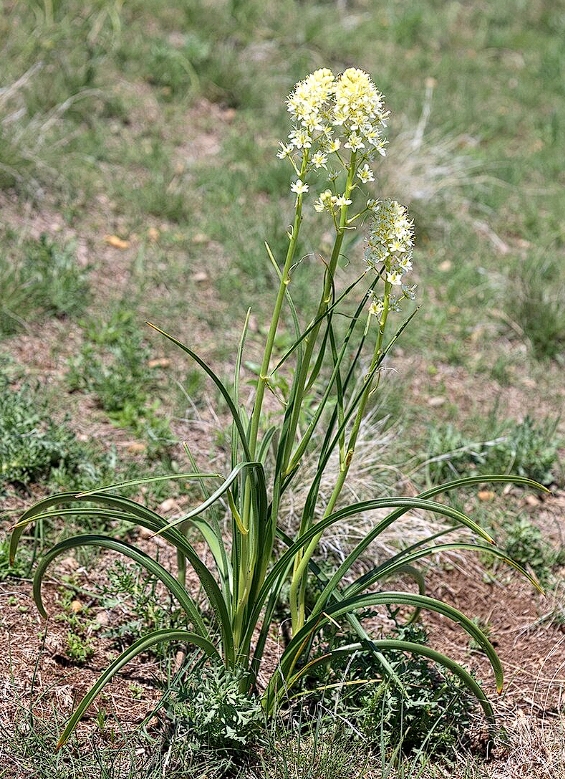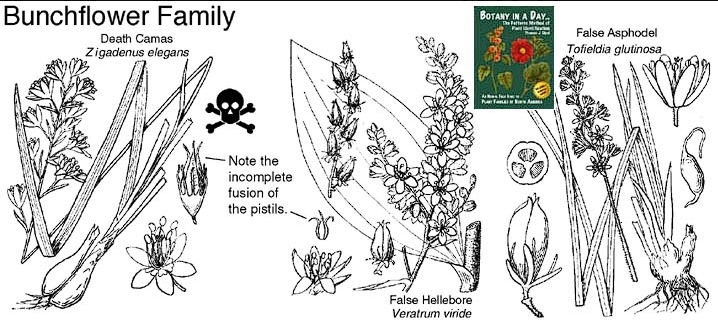Death Camas (Toxicoscordion venenosum): The Deadly Deceiver of the Pacific Northwest
Regional Significance in the Pacific Northwest
“Don’t eat white camas” is a common saying in the Pacific Northwest (Willamette Valley). It does not refer to a true member of the genus Camassia. Instead, it points to a native plant with similar bulbs from a different family. Above-ground structures are easy to spot as Toxicoscordion venenosum. People also call this plant Death Camas.
Clarifying the distinction between Camassia and Toxicoscordion
Both Camassia and Toxicoscordion live in the same types of habitats. However, only one of these plants has bulbs with deadly toxins.
Recognizing foliage, flowers, and seasonal
Before Native Peoples could safely harvest bulbs in North America, they needed to remove Toxicoscordion venenosum. This had to be done in the spring, before the flowers and fruit faded and the bloom white could be told apart.

Melanthiaceae – The family to which The Death Camas Toxicoscordion Venenosum
The herbaceous plant family Melanthiaceae exists throughout the northern half of the world. The quick-flowering plants exhibit their dynamic sepals and petals for people to recognize.

Taxonomic Evolution Modern Reclassification
Many of them have three-part corollas. Because of this, scientists once placed them in the Liliaceae family. However, the APG III system changed their classification in 2009.
Melanthiaceae has 17 genera divided into five class. It includes many spring flowers found in the Cascades, like trilliums and bear grass (Xerophyllum tenax).
Death Camas Toxicoscordion Venenosum

Growth Habit
Showy perennial monocot with many white flowers arising from a 12 to 25 mm diameter bulb.
Leaves
Basal, grass-like, and channeled with parallel veins. Grow up to 30 cm long, tapering up the stem and are somewhat rough to the touch.
Stems
range in height from 15 to 70 centimeters and are smooth, lacking any hairs.
Flowers
Inflorescence is a raceme of many flowers in a compact, terminal cluster. Foul smelling, creamy to yellowish white blossoms are bell shaped, with six petals and green glands at the base.
Fruits
Flowers produce cylindrical, papery capsules that are 8 to 14 mm wide.
Ecology
(In the Arid Western US) FACU, Facultative Upland species, can grow in a variety of environments from seasonally wet prairies to rocky cliffs, and forests below 2,600 meter above sea level.
Notes
The bulb and leaves of this plant are extremely poisonous to humans and grazing animals. Consuming as little as just 2 to 6% of one’s body weight can be fatal. Death Camas contains a chemical known as zygacine and other esters that are neurotoxins, interrupting normal neural activity. Unfortunately, bulbs have been confused with those of the edible C. quamash, C. leichtlinii, or alliums occurring in the same ecosystems, killing those who ingest them.
‘Many poisonings occur because death camas is mistaken for edible plants of the Asparagaceae family’.
FAQ About Death Camas Toxicoscordion Venenosum
This article was validated by:
Sources consulted:
Guard, J. (1995). Wetland Plants of Oregon and Washington. Lone Pine Publishing, Edmonton, Alberta.
Jepson eFlora: Toxicoscordion venenosa: http://ucjeps.berkeley.edu/eflora/eflora_display.php?tid=93851
Canadian Poisonous Plants Information System – Zigadenus venenosus http://www.cbif.gc.ca/eng/species-bank/canadian-poisonous-plants-information-system/all-plants-common-name/death-camas/?id=1370403267102>

